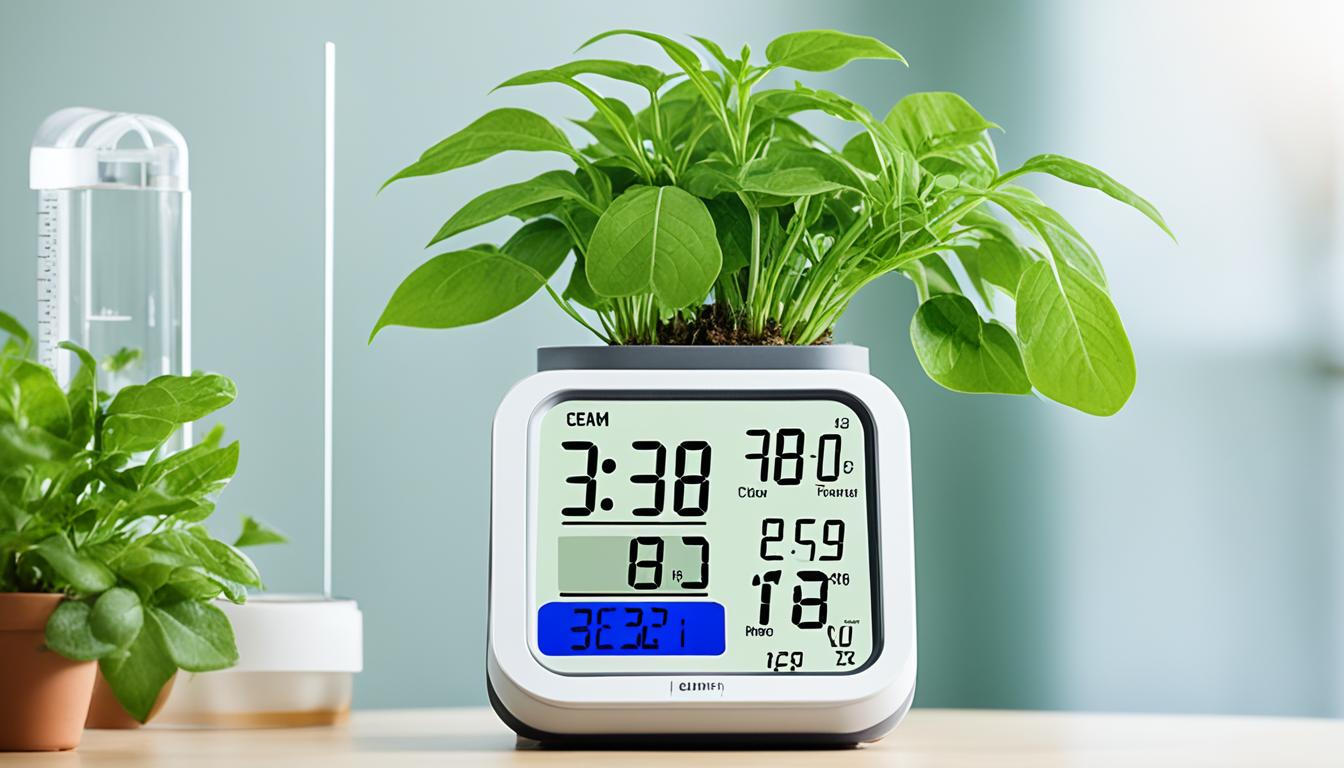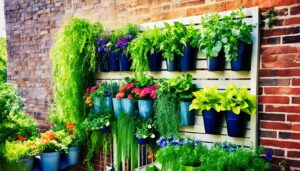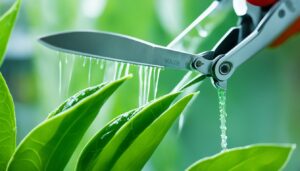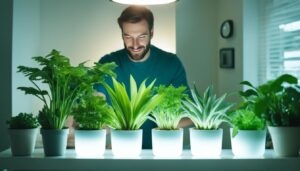Are you tired of seeing your indoor plants struggle with wilted leaves, stunted growth, or even fungal infections? The culprit might be the humidity level in your home. It’s important to keep the right balance of moisture in the air for your houseplants to thrive. But how do you know if your plants are getting the ideal humidity they need?
In this guide, we’ll help you understand your plants’ humidity needs. We’ll show you how to spot signs of improper humidity levels. And we’ll share effective ways to boost and maintain the perfect indoor humidity for your plants to stay lush and vibrant.
Understanding Plant Humidity Requirements
Understanding humidity is key to keeping indoor plants healthy. Humidity is the amount of water vapor in the air, measured from 0% (dry) to 100% (saturated). It’s crucial for plants to stay hydrated, control their temperature, and perform photosynthesis.
What is Humidity?
Relative humidity shows how much moisture is in the air versus its capacity to hold moisture at a certain temperature. Most houseplants do best in a humidity of 40-60%. This level is often higher than what’s usual indoors. Keeping your plants in this humidity is vital for their health.
Ideal Humidity Range for Houseplants
Houseplants need the right humidity level, based on where they come from. Tropical and subtropical plants, which are common, prefer 60-80% humidity to mimic their natural home. Succulents and cacti, however, can handle 10-40% humidity. Most indoor plants do best in 40-60% humidity, which is ideal for growth and health.
| Plant Type | Ideal Humidity Range |
|---|---|
| Tropical and Subtropical Plants | 60-80% Relative Humidity |
| Succulents and Cacti | 10-40% Relative Humidity |
| Most Indoor Plants | 40-60% Relative Humidity |
Knowing what humidity your indoor plants need helps you create the best environment for them. This ensures they stay healthy and live longer.
Signs of Improper Humidity Levels
Keeping the right humidity levels is key for your indoor plants’ health. If the air gets too dry, your plants will show stress signs. Knowing these signs of low humidity in plants helps you fix the problem fast. This ensures your plants get the best growing conditions.
Low Humidity Signs in Plants
One sign of symptoms of dry air for indoor plants is crispy, brown leaf edges. Plants can’t hold water in dry air, causing leaves to dry and curl. You might also see wilting or drooping leaves, showing the plant can’t move water well.
Stunted growth is another sign of plant care for low humidity. Dry air hinders growth, making leaves small, stems short, and plants look less vibrant.
Dull, lifeless leaves are common with low humidity. Leaves lose their shine and look unhealthy. Pests and diseases can also hit harder in dry air, weakening the plant’s defenses.
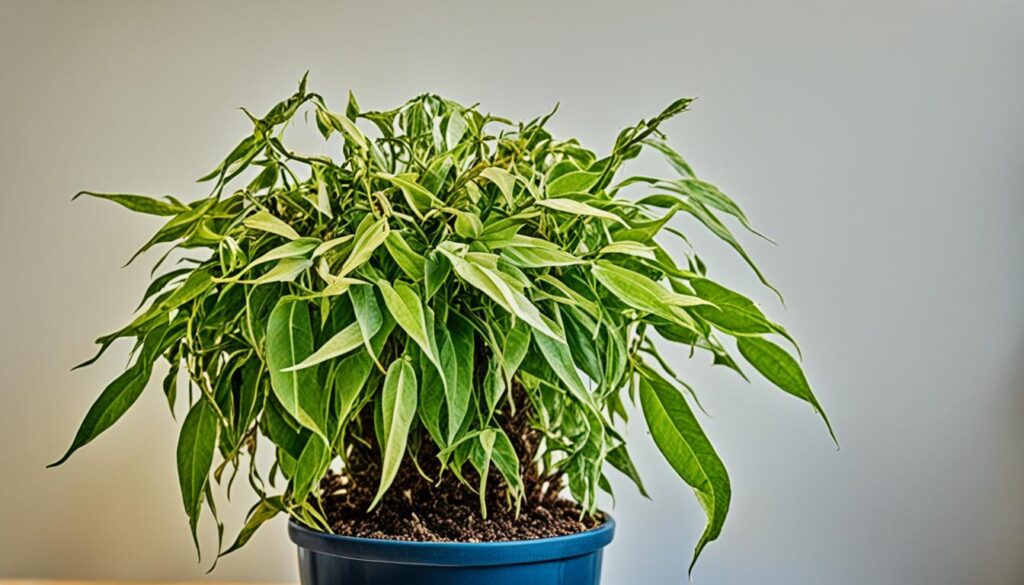
Spotting these signs of low humidity in plants lets you fix the issue early. By tackling the problem and boosting humidity, you can make your plants healthy and lively again.
indoor plant humidity levels
Keeping the right humidity levels is key for your indoor plants’ health. Regularly checking the humidity in your home is a must. Use a hygrometer, a tool made to measure humidity, to spot and fix any issues.
Try to keep humidity in your home between 40-60% for most plants. Some plants need more or less humidity, so check what each plant likes. Monitoring indoor humidity levels and adjusting them will help your plants stay healthy and look great.
Measuring Humidity for Houseplants
Put a hygrometer for plants in different spots in your home. This will show you the humidity levels your plants are in. This info helps you make the best environment for your plants to grow.
| Humidity Level | Ideal for |
|---|---|
| 40-50% | Most houseplants |
| 50-60% | Tropical and humidity-loving plants |
| Below 40% | Cacti and succulents |
By often monitoring indoor humidity levels and adjusting them, you can make sure your plants get the right moisture. This keeps them healthy and looking good.
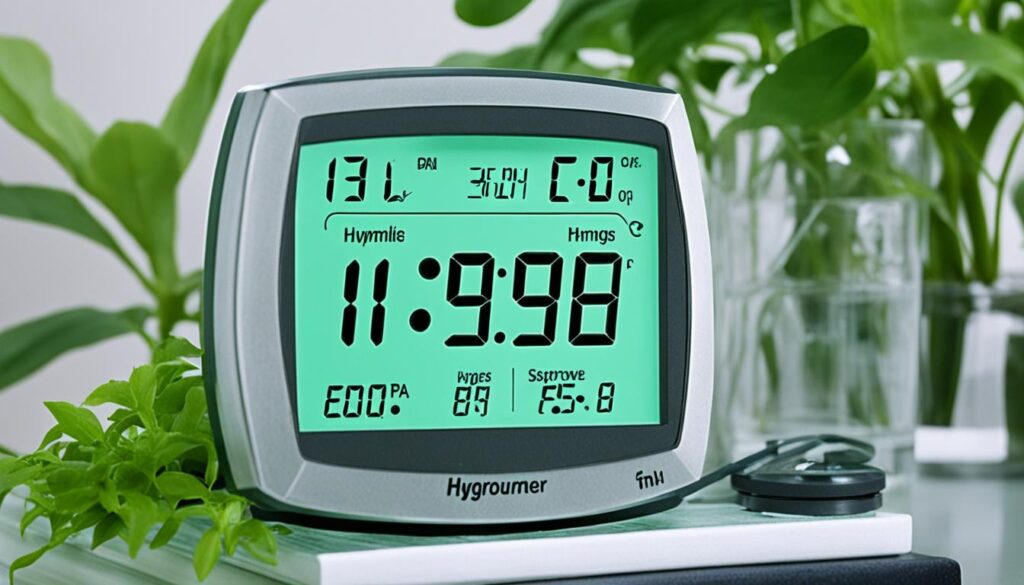
Boosting Humidity for Indoor Plants
Keeping the right humidity levels is key for your indoor plants to stay healthy and thrive. You can boost humidity by using a humidifier for indoor plants or by misting your houseplants.
Humidifier for Indoor Plants
A humidifier is a great way to increase humidity for houseplants. These devices add moisture to the air, making a better plant-friendly environment. When picking a humidifier, think about size, how long it runs, and features that fit your plants and space. Choose one made for plant care to get the best humidity for indoor plants.
Misting Indoor Plants
Misting your plants is an easy, affordable way to temporarily boost humidity around plants. Use a spray bottle with clean, chlorine-free water and mist the leaves gently. Be careful not to get water on plants with fuzzy or hairy leaves, as it can cause fungal problems. While misting helps quickly, it’s important to keep moisture levels steady with other plant misting techniques for your plants’ long-term health.
Proper humidity levels are essential for the thriving of your indoor plants. By incorporating a humidifier or regular misting, you can create the ideal environment for your greenery to flourish.”
Using a humidifier and misting together can really increase humidity around plants. This ensures your indoor plants get the moisture they need to do well. Try these methods to find the best balance for your plants and home.
Alternative Methods to Increase Humidity
Humidity Trays for Plants
Looking for a way to boost humidity for your indoor plants? Try using humidity trays, also known as pebble trays. These simple devices create a microclimate of more moisture around your plants. This helps them grow better.
Setting up humidity trays is easy and keeps them simple to maintain. Fill a tray with pebbles or small stones and add water just below the top. Put your plant’s pot on top, making sure it’s not in the water. As the water evaporates, it increases the humidity around your plant.
- Humidity trays for plants are a cost-effective and low-maintenance way to improve humidity levels.
- Pebble trays for houseplants can be customized to fit your specific plant’s needs and the size of your space.
- DIY humidity trays for indoor plants are simple to create using common household items.
Adding humidity trays to your plant care routine is an easy and effective way to give your indoor plants the moisture they need. You don’t need complex equipment or high-tech solutions.
Maintaining Ideal Humidity Levels
Keeping the right humidity for your indoor plants is key. It needs regular checks and adjustments. By watching their humidity needs and using different methods, you can make sure they get the right moisture to grow well.
First, use a hygrometer to check the humidity in your space often. This lets you see if the levels are right or not. Most houseplants do best when the humidity is between 40-60%.
To keep humidity right, try different methods based on your plants and space. Strategically placed humidifiers can add moisture. Misting your plants gives them a quick moisture boost. Humidity trays with water and pebbles can also raise the moisture around your plants.
Change your approach with the seasons, as humidity changes with temperature and air movement. By watching and adjusting as needed, your plants will get the optimal moisture they need to grow and stay healthy.
Remember, the right humidity isn’t the same for all plants. Each type has its own needs. Watch how your plants react and adjust as needed. With some trial and attention to detail, you can manage indoor humidity perfectly for your houseplants.
Conclusion
Getting the right humidity balance is key for your indoor plants to thrive. Know what your plants need, spot when the moisture is off, and use the best methods to keep it right. This way, you’ll have a lush indoor garden.
Right humidity levels make your plants healthy and your space look better. You can use a humidifier, mist them, or try humidity trays. The hard work in managing humidity pays off with a green, lively garden that brightens your home.
With the right knowledge and action, you can handle indoor plant humidity well. Learn about your plants, try new things, and see how keeping moisture right changes your indoor space. It’s a journey that brings you closer to nature and lifts your mood.
FAQ
What is humidity and why is it important for indoor plants?
Humidity is the amount of water vapor in the air, shown as a percentage. It’s key for plants to stay hydrated and grow well. Most houseplants do best in 40-60% humidity, which is more humid than usual indoors.
What is the ideal humidity range for most indoor plants?
Most indoor plants prefer 40-60% humidity for healthy growth. Tropical plants like more, 60-80%. Succulents and cacti can handle 10-40% humidity.
What are the signs of low humidity in indoor plants?
Signs of low humidity include dry, brown leaf edges and wilting leaves. Plants may grow slowly, have dull leaves, and be more prone to pests and diseases. These signs mean the plant is losing water too fast.
How can I monitor the humidity levels in my indoor environment?
Use a hygrometer to check humidity levels. It helps spot areas needing adjustment to keep plants happy.
What are some effective ways to increase humidity for my indoor plants?
To boost humidity, try using a humidifier, misting your plants, or using humidity trays. These methods add moisture to the air, making it better for plants.
How can I maintain the ideal humidity levels for my indoor plants?
Keep an eye on humidity levels with a hygrometer and adjust as needed. Change your methods based on the season, plant type, and your environment. Use humidifiers, misting, and trays to keep moisture levels right for your plants.


